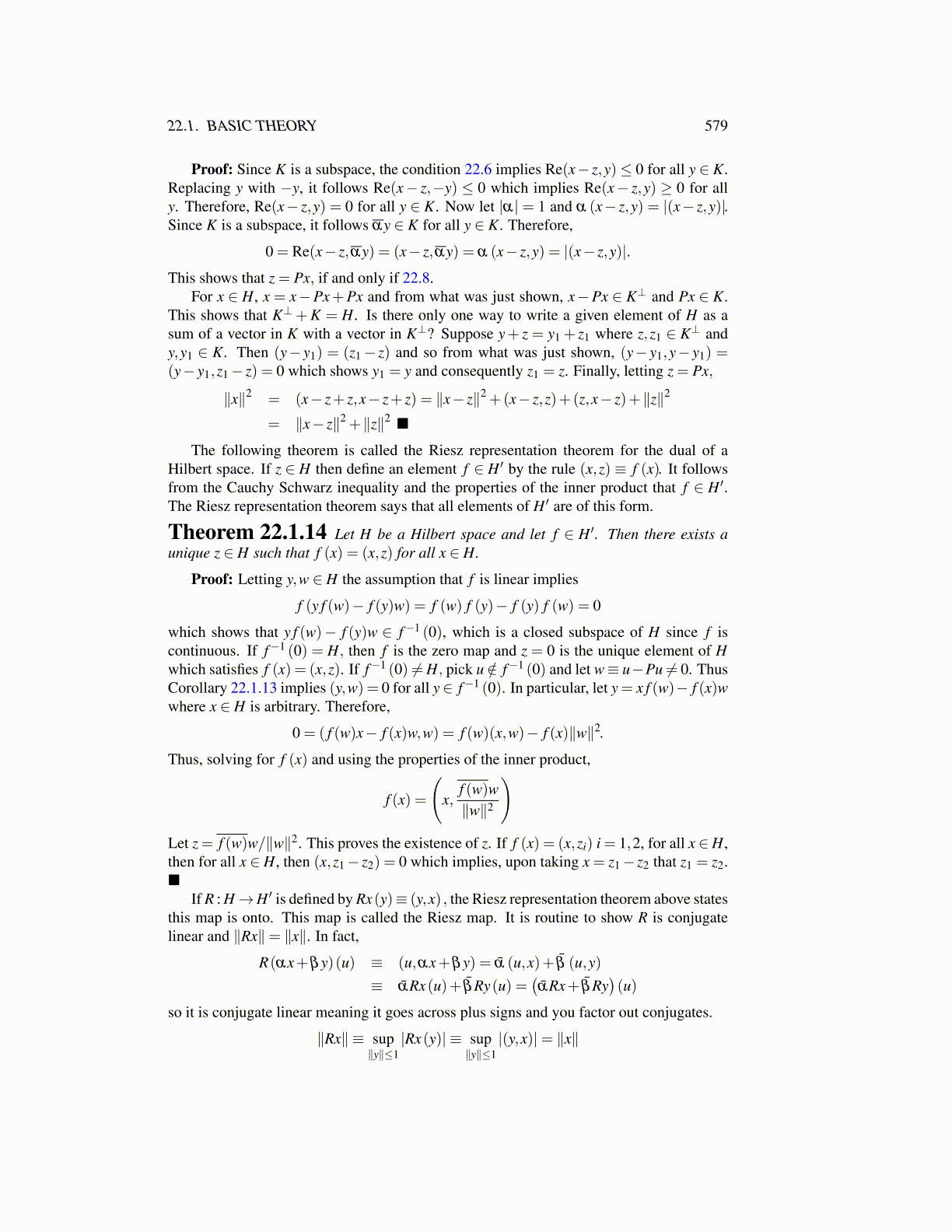
22.1. BASIC THEORY 579
Proof: Since K is a subspace, the condition 22.6 implies Re(x− z,y)≤ 0 for all y ∈ K.Replacing y with −y, it follows Re(x− z,−y) ≤ 0 which implies Re(x− z,y) ≥ 0 for ally. Therefore, Re(x− z,y) = 0 for all y ∈ K. Now let |α| = 1 and α (x− z,y) = |(x− z,y)|.Since K is a subspace, it follows αy ∈ K for all y ∈ K. Therefore,
0 = Re(x− z,αy) = (x− z,αy) = α (x− z,y) = |(x− z,y)|.This shows that z = Px, if and only if 22.8.
For x ∈ H, x = x−Px+Px and from what was just shown, x−Px ∈ K⊥ and Px ∈ K.This shows that K⊥+K = H. Is there only one way to write a given element of H as asum of a vector in K with a vector in K⊥? Suppose y+ z = y1 + z1 where z,z1 ∈ K⊥ andy,y1 ∈ K. Then (y− y1) = (z1− z) and so from what was just shown, (y− y1,y− y1) =(y− y1,z1− z) = 0 which shows y1 = y and consequently z1 = z. Finally, letting z = Px,
∥x∥2 = (x− z+ z,x− z+ z) = ∥x− z∥2 +(x− z,z)+(z,x− z)+∥z∥2
= ∥x− z∥2 +∥z∥2 ■
The following theorem is called the Riesz representation theorem for the dual of aHilbert space. If z ∈ H then define an element f ∈ H ′ by the rule (x,z) ≡ f (x). It followsfrom the Cauchy Schwarz inequality and the properties of the inner product that f ∈ H ′.The Riesz representation theorem says that all elements of H ′ are of this form.
Theorem 22.1.14 Let H be a Hilbert space and let f ∈ H ′. Then there exists aunique z ∈ H such that f (x) = (x,z) for all x ∈ H.
Proof: Letting y,w ∈ H the assumption that f is linear implies
f (y f (w)− f (y)w) = f (w) f (y)− f (y) f (w) = 0
which shows that y f (w)− f (y)w ∈ f−1 (0), which is a closed subspace of H since f iscontinuous. If f−1 (0) = H, then f is the zero map and z = 0 is the unique element of Hwhich satisfies f (x) = (x,z). If f−1 (0) ̸= H, pick u /∈ f−1 (0) and let w≡ u−Pu ̸= 0. ThusCorollary 22.1.13 implies (y,w) = 0 for all y∈ f−1 (0). In particular, let y = x f (w)− f (x)wwhere x ∈ H is arbitrary. Therefore,
0 = ( f (w)x− f (x)w,w) = f (w)(x,w)− f (x)∥w∥2.
Thus, solving for f (x) and using the properties of the inner product,
f (x) =
(x,
f (w)w∥w∥2
)Let z = f (w)w/∥w∥2. This proves the existence of z. If f (x) = (x,zi) i = 1,2, for all x ∈H,then for all x ∈H, then (x,z1− z2) = 0 which implies, upon taking x = z1− z2 that z1 = z2.■
If R : H→H ′ is defined by Rx(y)≡ (y,x) , the Riesz representation theorem above statesthis map is onto. This map is called the Riesz map. It is routine to show R is conjugatelinear and ∥Rx∥= ∥x∥. In fact,
R(αx+βy)(u) ≡ (u,αx+βy) = ᾱ (u,x)+ β̄ (u,y)
≡ ᾱRx(u)+ β̄Ry(u) =(ᾱRx+ β̄Ry
)(u)
so it is conjugate linear meaning it goes across plus signs and you factor out conjugates.
∥Rx∥ ≡ sup∥y∥≤1
|Rx(y)| ≡ sup∥y∥≤1
|(y,x)|= ∥x∥